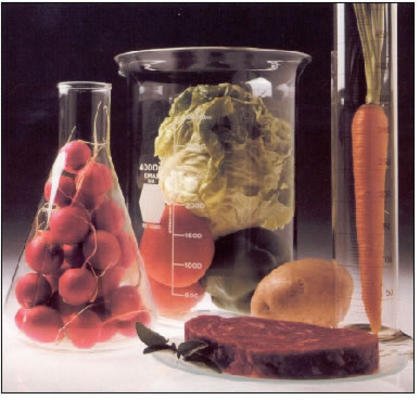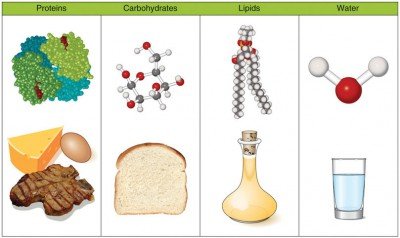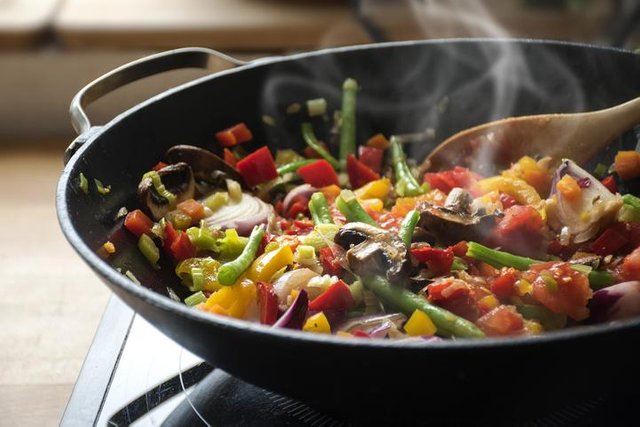COOKING CHEMISTRY
Chemistry is a science that studies the composition, properties, and structures of material substances as well as the changes that occur when reacting with other substances.
Starting from this very brief definition, we can imagine that we are surrounded by chemistry; We do not have to go far and look into our daily lives. Surely you or I or everyone has entered a kitchen to make a plate of food. Nor is there an expert chef; simply frying an egg, sautéing or boiling some vegetables, cooking a piece of meat, ... we are producing, without realizing it, physical changes and chemical reactions.

Source
Before discussing a few reactions that take place in the kitchen, we will mention something about foods and what they are composed of.
We could divide the food into three large groups; proteins, carbohydrates, and fats. They would also be composed of inorganic minerals and organic substances, such as vitamins, acids, oxidants, and antioxidants.
• Proteins are composed mainly of carbon, hydrogen, nitrogen, and oxygen. We can find them both in animals and in plants and they help us to form structures such as skin, hair, nails, muscles ... An example of the protein is the lactoglobulin found in milk.
• Carbohydrates are composed of carbon, hydrogen, and oxygen. In them, we can find sugars, starch, cellulose, pectins, ... Some foods that contain carbohydrates are sugar, fruits, bread, pasta, ... An example of carbohydrate is the glucose found in sugar.
• Fats are the enemies of all diets, especially if you are overweight or obese. We can find two types of fats: saturated and unsaturated.
Unsaturated fats do not contain hydrogen atoms and are liquid at room temperature, their most common example being oil.
Saturated fats are characterized because each hydrogen atom is attached to a carbon atom and at room temperature they are solid. We can find them in red meats, dairy products, and derivatives .
• Minerals are substances that regulate the functions of the organism, in the diet we find them in small quantities but they perform very important functions. They are eliminated by urine or sweat. The most important minerals needed are; We can find sodium, magnesium, calcium, phosphorus, iron, fluorine and iodine in different foods such as milk, pulses, nuts.
• Vitamins are also substances that the body needs in small amounts to regulate its functions. The organism can not synthesize them, so it has to acquire them through food. They are divided into two groups:
Water soluble (soluble in water): vitamin B and vitamin C.
Liposoluble (soluble in fat): vitamins A, D, K and E.

Source
In nature, we find foods in a raw state. Many of them need to modify their chemical composition through the application of heat to make them digestive, and others are consumed raw. Through the different methods of cooking what we achieve is to make the food more tasty and appetizing, we change its appearance and texture, and also, when we cook we are destroying almost all the microorganisms (the cooking starts at almost 36º, that is to say, this temperature is already beginning to destroy the bacteria).
We can divide the cooking methods according to the way we do them:
•Cooking in the dry or concentrated medium: When we use this cooking method, we evaporate a large part of the water and the elements are concentrated in the food. The heat makes it seal the pores of the food and does not let the juices escape, that is why they are so appetizing, but the cooking time will have to be taken into account. We can find different culinary techniques such as: roasting in the oven, grilling/griddle, gratin, sautéing / sautéing, grilled.
• Cooking in wet or expansion medium: When we use this method of cooking, we immerse the food in some liquid (water, broth, milk, ...), with this, we get the soluble elements such as vitamins and minerals to dissolve during cooking. We can find different culinary techniques such as boiling, bleaching, pochard, steaming.
•Cooking in mixed medium or by combination: In this cooking method we find two stages, the first one cooks the food by dry heat in a fat, and second, we finish it by moist heat. Apart from the cooking of the food, we obtain a by-product a sauce or juice. We can find different culinary techniques such as stewing, stewing, braising.

Source
We have seen that food is composed of chemical elements necessary for our organism and to cook them we use diverse chemical reactions.
Curious fact
Why do we cry when we cut onions? We also provoke reactions when we cut. A very simple example is the onion that makes us cry when we cut it. What we are doing without realizing when cutting an onion, is that we mix an enzyme and a protein that combined cause a compound with a characteristic smell and makes it attack the glands tears. Being soluble in water, if we wet with water the knife in which we cut, we will avoid crying.
For more information visit the following links
Related Posts
I hope you liked it, and that it will be useful, thank you for your time, do not forget to comment and, if you liked, vote and follow me for more material like this. @robertoromero
What a nice post, i followed, please follow back. :-)
it's good that you liked it! Thank you
Amazing post! Keep them coming!
Thanks for reading.